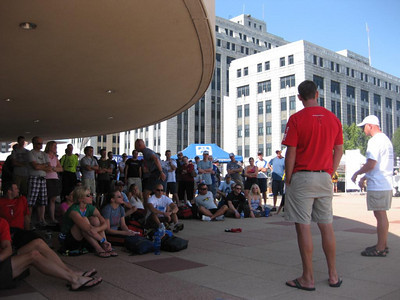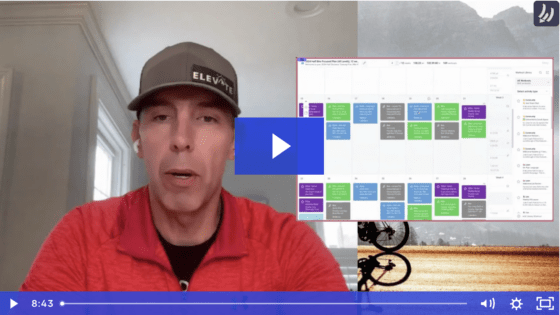The Endurance Nation “Four Keys” To Ironman® Execution
What started as an article after Florida in 2007 has now evolved into a true movement. Ironman® and Half Iron triathletes of all ability levels are taking advantage of our proven race guidance achieving incredible results!
Some use our Four Keys DVD, while others are initiated after attending one of our free on-site Ironman® Pre-Race talks. Regardless of which option you choose, know that improving your next race can be significantly cheaper than those new wheels you are considering, or easier than that new whizzbang training method you’ve read about — master the four keys, focus on what matters, and race to your potential!
We have a lot of experience with what works, what does not work, and we’ve honed this message through the results of our athletes, our observations while being ON the course during the race, and the feedback we’ve received from pre-race talk attendees. Over the years, thousands have used the Four Keys to set massive PR’s, earn Kona slots, place themselves on the podium, and win age groups.
>> Click Here to Watch the Full Two-Hour Video! <<
This is the official Endurance Nation Ironman® Kool-Aid, we hope you enjoy it. Help us help you!
The Four Keys
- Execution, not Fitness. All you’ve done for 9 months is build a vehicle. Ironman® racing is about how you DRIVE that vehicle, it is NOT about the vehicle. The majority of athletes on race day are fitness-focused (look at my T-shirt, look at my abs/veins/etc, look at how fast I can go in the first hour of the bike, etc.) It’s easy to get caught up in the buzz and energy of the day, but creating and sticking to the right plan for you is the only thing that will lead to the best possible day.
- The Line. Nothing on race day really matters until you reach The Line on the run. The Line is the point at which continuing becomes very, very difficult. You define success as simply not slowing down at The Line. EVERYTHING before The Line is simply about creating conditions for success for when the Line comes to you.Additional Kool-Aid flavored thoughts we’d like to put in your head regarding this point are:
-
- A successful race = a good run. There is no such thing as a good bike followed by bad run, period. In our world, if you showed up with solid run fitness, had a “good” bike and a poor run, we will ALWAYS assume you messed up your bike pacing, until proven otherwise.
- If you think you can ride faster than we’re telling you, prove it by running well off the bike.
- Ride your “should” bike split vs your “could” bike split. Your Could split is what you tell your friends you could ride on a good day, when you’re out together for your Saturday ride. If you say you “could ride a 5:50,” your Should split is likely 6:00 and is defined as the bike split that yields a good run (see #1 and #2 above).
- In our experience, 80-90% of the Ironman® field doesn’t know how to race. If you find yourself doing the opposite of everyone else, you’re doing the right thing. If Jimmy is “king of this random hill” at mile 46 of the bike…don’t join him! Lots of people passing you in the first 40 miles? That’s good, don’t join in. Going backwards through the field on a hill? Great!
- Think you made the mistake of riding too easy? You now have 26 miles to fix that mistake. Make the mistake of riding too hard? That mistake now has 26 miles to express itself, to the tune of X miles at 17-18′ walking pace vs X miles at 8-12′ running pace. Do the math. How great is that bike split going to look as you are walking/shuffling the last 10 miles of the run? The Ironman® run course is littered with fit doodes walking and talking about what a great bike split they had. Don’t join them.
- Every time you feel yourself about to roll the dice and race, look at where you are. Are you at The Line / Mile 18? If not, please stick to the plan!
3. The Box: All day long you are going to race inside a box defined by what you can control. Ask yourself “What do I need to do right NOW to create the conditions for success at The Line? Is what I’m doing right now counter to this goal? From what we’ve seen first hand on the IM courses, we believe you should ask yourself “Am I participating in some short-term tactical masturbation?” If yes, STOP!!
On the swim, the Box is the space your body occupies in the water: focus on your form and the rest will come. On the bike, the box is probably about one aid station long. On the run, the box begins as 2-3 aid stations long but often diminishes to “from here to the next lampost/manhole cover/mail box.” Regardless:
-
- Keep the box as big as you can for as long as you can.
- Keep in the box only the things you can control. Let go of the rest.
- Exercise this decision-making process inside your box: Observe the situation, Orient yourself to a possible course of action, Decide on a course of action, Act (OODA Loop).
4. The One Thing. If you swallowed the Kool-Aid we’re serving you here, you will show up at the Line, in your Box, ready to git’erdun and simply not slow down. But we’re not done yet. There is still some psychological stuff you need to address. During the course of your race day, expect your body to have a conversation with your mind:
“Look, Mind, you’ve had me out here slogging away for 132 miles. This is really starting to get old and very painful. You need to give me a good reason to keep going forward. If you don’t have one, I’m gonna slow down and you can’t stop me!”
Before the race ask yourself “Why am I doing Ironman?” Your goal here is to determine what is the One Thing that put you in this race. To finish in the daylight with a smile on your face? To run a 4:10? To honor your family or a loved one?
Whatever your One Thing is, be absolutely clear and rehearse your mind/body debate beforehand. Be warned: your body can be a helluva good negotiator at mile 18, especially if your mind hasn’t prepared its rebuttal arguments beforehand.
>> Click Here to Watch the Full Two-Hour Video! <<
What have we not talked about so far?
The things you are likely most torqued about: heart rate, pace, speed, watts, how to eat, what to drink, etc. We believe that if you can keep yourself focused on the Four Keys above, the rest of the day is relatively simple and you don’t need to worry about these relatively small details. In other words, all the whizbang guidance in the world can’t help you if don’t have your mind right about the Four Keys above.
But because you’re a Type A Triathlete and you want the details, here they are:
- The Swim: Swim only as fast as your ability to maintain form. When you feel your form go, slow down. Counting strokes is an excellent technique for bringing your mind out of the race and into the Box of maintaining your form.
- The Bike: JRA (Just Ride Along) for about 45-60′. Then shift from JRA to Easy (5:45+ should split) to Steady (sub 5:45 should split). Gauge how well you’re doing by how well you’re NOT doing what everyone else is doing.
- The Run: Jog for 4-6 miles, with a jogging, do-no-harm pace and heart rate cap. Jogging is defined as a pace you could sustain for hours if we kept feeding you. After 4-6 miles, shift from jogging to “running,” running comfortably, getting what you need, and preparing yourself for the Line, where things become very uncomfortable. At the Line, just suck it up and giterdun.
Conclusion
That’s it, that’s as complicated as racing Ironman® needs to be and we can’t say it any more simply. We’ve basically given you a Vegas betting strategy, having managed and observed many rolls of the dice through our experience as Ironman® coaches leading a team of 400 long course athletes. If you can keep a macro-level focus, the little things will fall into place and you will have a good day. But as you stray towards the Ricky Racer side of the execution scale, you begin to rattle the dice.





Bonnie
Love this article! It totally is in line with my philosphy about training and race day. My longest distance has been an Olympic but this is my year to do a 70.3.
Great advice and well-written.
Bonnie